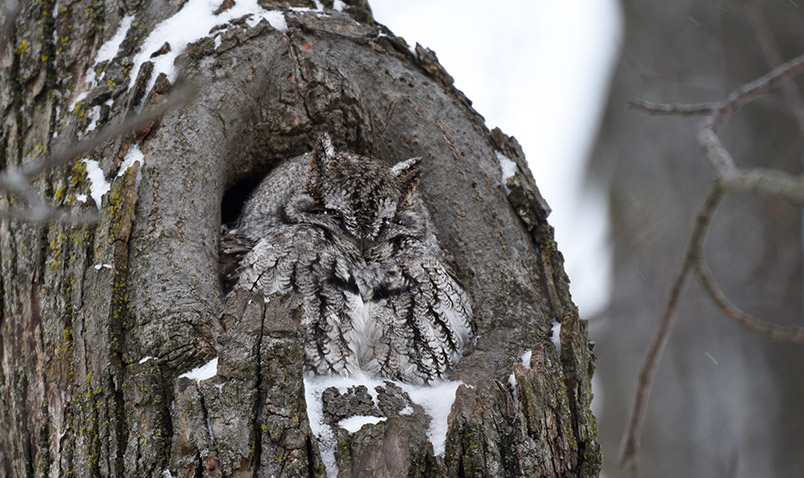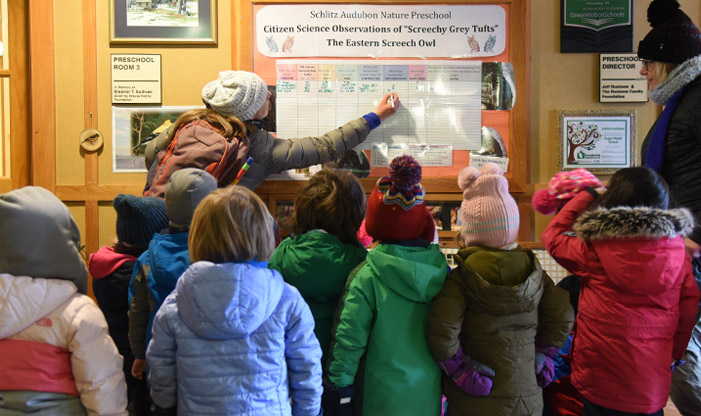All children can aspire to be scientists. That’s what they learn in our Nature Preschool, where our littlest students participate in a Citizen Science project centered on one of their favorite animals. It’s an Eastern Screech Owl, who the children call Screechy Grey Tufts, that visits the Center each year during fall and winter.
Characteristics of the Eastern Screech Owl
 Eastern Screech Owls are common east of the Rockies, and come in red and grey varieties, called morphs. The owl at Schlitz Audubon is most likely female, based on its larger size compared to a male of the same species. She is a grey morph, which represents two-thirds of this type of owl. There are also intermediate brown varieties. Eastern Screech Owls are short and stocky, with pointed ear tufts. This species is one of the smallest owls in Wisconsin, measuring 6-10 inches long with a wingspan of 19-24 inches. It has complex bands and spots which work as camouflage. These owls live in woods, parks, and suburbs.
Eastern Screech Owls are common east of the Rockies, and come in red and grey varieties, called morphs. The owl at Schlitz Audubon is most likely female, based on its larger size compared to a male of the same species. She is a grey morph, which represents two-thirds of this type of owl. There are also intermediate brown varieties. Eastern Screech Owls are short and stocky, with pointed ear tufts. This species is one of the smallest owls in Wisconsin, measuring 6-10 inches long with a wingspan of 19-24 inches. It has complex bands and spots which work as camouflage. These owls live in woods, parks, and suburbs.
The Eastern Screech Owl’s diet is consists primarily of small rodents, though they also eat worms and insects. Evidence of their diet is observable in their pellets, which are undigested bits of their food. They are formed when the indigestible bones, fur, teeth, and insect shells are regurgitated as tightly formed balls roughly the size of a human thumb. Pellets can be found on the ground near the owl’s roost and are sometimes retrieved for the purpose of dissection.
As a part of their Citizen Science project, all three of Schlitz Audubon Nature Preschool classes, as well as classes from Malaika Early Learning Center, check where the owl usually is to document what types of conditions it is commonly seen in. The children and teachers will gather information, such as wind speed, sky conditions, temperature (including real feel), and importantly, whether the owl is present. The sky and wind conditions are framed in a sensory manner that young ones can relate to. A gentle wind is described as wind felt on face and leaves rustling. A stronger wind means dust rises and small branches move.
Interacting with Nature
Through data collection, preschoolers have learned that owl visits on cloudy as well as sunny days, whereas previously they thought she mostly came on sunny days. The owl is sometimes hard to find, however. Students must look carefully because its camouflage effectively hides it from view, presenting a great learning opportunity.
This exercise leads to questions and greater observational abilities, and students often become very interested in learning even more. Citizen Science often increases the range of young ones’ appreciation of the natural world and their ability to engage with it. The preschoolers already visit Baron Von Screech and Tucker, Eastern Screech Owls from our Raptor Program that are brought to the classroom. Through this Citizen Science project, they can experience the beauty of this species in the wild.
All the information collected is marked on an observation chart in the entrance hallway of the preschool. Though the project is designed for the preschoolers, everyone can join in. Parents often check the observation chart when they drop their child off for school.
Goals for Preschool Citizen Science
Gathering data is not the end goal of this Citizen Science project, however. Introducing young ones to the idea of being a scientist and of being a part of a community is a major aim. Each child learns that they can be a scientist, and that people can work together to accomplish a goal. This program is designed to make science accessible to preschoolers, and to empower them. It encourages preschoolers to care about the environment.
Another component of their education is learning to be empathetic. Students who interact with animals and nature begin to care about it. They even want to take care of insects, worms, and slugs instead of fearing or harming them. As for the owl, the children don’t just want to see it; they want to know how she is doing. This is a skill students teach their families, where they might become the motivating force to do something like recycle or compost at home in order to be kind and responsible to the earth. Their excitement is infectious.
At Schlitz Audubon Nature Preschool, we take these qualities that are inherent in children and nurture them. Students become teachers and environmental stewards, and share their enthusiasms. Getting to know this Eastern Screech Owl in the wild is one way we encourage empathy and respect for life.


